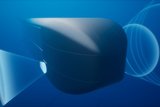Northrop Grumman marks delivery of E-2D Advanced Hawkeye to the US Navy fleet
The first Northrop Grumman built E-2D Advanced Hawkeye aircraft to enter the US Navy fleet was "welcomed home" on Thursday in a ceremony held at Norfolk Naval Air Station in Virginia.
As US Navy leadership, Northrop Grumman officials and members of the US Navy's E-2 community looked on, Admiral Gary Roughead, chief of naval operations, accepted delivery of the aircraft on behalf of the US Navy. "Today is a major naval aviation milestone," Roughead said. "The E-2D is ready, relevant and capable. It's going to be a game changer with information dominance for the US Navy. I am very pleased today to accept delivery of the first E-2D to enter the US Navy fleet."
As the US Navy's carrier-based airborne early warning and battle management command and control system, the E-2D Advanced Hawkeye, with its newly developed AN/APY-9 radar, works in concert with surface combatants equipped with the Aegis combat system to detect, track and defeat cruise missile threats at extended range. A new rotodome contains critically important, continuous, 360-degree scanning capability, while adding an electronically scanned array. This system allows operators to focus the radar on selected areas of interest.
Under a $408 million contract, awarded in July 2007, Northrop Grumman is producing two additional pilot production aircraft which are on track for delivery in 2010. Manufacturing of four Low-Rate Initial Production aircraft also is progressing well.
"The men and women of Northrop Grumman go to work each day with no greater priority than supporting the warfighter," said Gary Ervin, corporate vice president and president of Northrop Grumman Aerospace Systems. "The E-2D's systems represent a multi-generational leap in technology. It is built to be relevant for decades to come and will greatly facilitate how the Navy manages the complex, modern battlespace and emerging threats of today and tomorrow."
The first Navy squadron to operate the E-2D Advanced Hawkeye is Airborne Early Warning Squadron ONE TWO ZERO (VAW-120), based in Norfolk. As the Navy's Fleet Replacement Squadron (FRS), the "Greyhawks" train pilots and naval flight officers to fly the aircraft and operate the systems before assignment to an operational flight squadron.
Source: Northrop Grumman
More from Digital Battlespace
-
![Babcock nears first customer for Nomad AI translation tool]()
Babcock nears first customer for Nomad AI translation tool
Nomad can provide militaries with real-time intelligence, saving critical time on the battlefield.
-
![AUSA 2025: Israel’s Asio Technologies to supply hundreds of improved Taurus tactical systems]()
AUSA 2025: Israel’s Asio Technologies to supply hundreds of improved Taurus tactical systems
Taurus operates alongside the Israel Defense Forces’ Orion system which supports mission management across tens of thousands of manoeuvring forces, from squad leaders to battalion commanders.
-
![AUSA 2025: Kopin pushes micro-LED plans as China moves faster]()
AUSA 2025: Kopin pushes micro-LED plans as China moves faster
The plan for the new displays follows fresh investment in Kopin’s European facilities by Theon and an order for head-up displays in fielded aircraft, with funding from the US Department of Defense.
-
![AUSA 2025: Persistent Systems to complete its largest order by year’s end]()
AUSA 2025: Persistent Systems to complete its largest order by year’s end
Persistent Systems received its largest ever single order for its MPU5 devices and other systems earlier this month and has already delivered the 50 units to the US Army’s 4th Infantry Division.
-
![Aselsan brings in dozens of companies and systems under the Steel Dome umbrella]()
Aselsan brings in dozens of companies and systems under the Steel Dome umbrella
Turkey has joined the family of countries attempting to establish a multilayered air defence system with government approval in August 2024 for the effort landed by Aselsan. Dubbed Steel Dome, the programme joins Israel’s Iron Dome, the US Golden Dome, India’s Mission Sudarshan Chakra and South Korea’s low-altitude missile defence system.
-
![DSEI 2025: MARSS unveils new agnostic multidomain C4 system]()
DSEI 2025: MARSS unveils new agnostic multidomain C4 system
MARSS’ NiDAR system has been deployed using sensors from static platforms to provide detection and protection for static sights, such as critical infrastructure, ports and military bases.



























